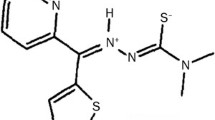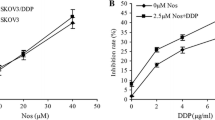Abstract
Purposes: To evaluate the antiproliferative activity of contragestazol (DL111-IT) in vitro and in vivo and to elucidate potential molecular mechanisms. Methods: Cell killing ability of DL111-IT was measured by MTT/Trypan blue exclusion method and murine and human tumor models; cell cycle was analyzed by flow cytometry; pRb, CDK4 and Cyclin D1 expressions were detected by western blotting. Results: DL111-IT exhibited high efficiency on cell growth inhibition of 12 cancer cell lines, the IC50 values were 4.1–19.7 μg/ml. In Sarcoma-180 (S180) and Hepatoma-22 (H22) tumor bearing mice models, the inhibition rates were 55.9 and 55.6%, respectively, at the doses of DL111-IT 12.5–50.0 mg/kg for 9 days consecutive administration. Human ovarian carcinoma (HO-8910) xenograft study showed that, nine administrations (within 15 days) of DL111-IT (12.5–50.0 mg/kg) significantly inhibited tumor growth with the inhibition rates ranging from 17.0 to 64.3%. DL111-IT induced G1 arrest and overexpression of pRb, CDK4 and Cyclin D1 were observed in HO-8910 cell line, suggesting that cell cycle regulation might contribute to the anticancer property of DL111-IT. Conclusions: DL111-IT could inhibit the proliferation of cancer cells both in vitro and in vivo via a cell cycle regulation pathway.





Similar content being viewed by others
References
Galliani G, Luzzani F, Colombo G, Conz A, Mistrello L, Baroae D, Lancini GC, Assandri A (1986) On the mode of action of a new contragestational agent (DL111-IT). Contraception 33:263–283
Yang B, Fang RY (1996) Synergistic effects on pregnancy-termination activity of DL111-IT in combination with mifepristone. Acta Pharmacol Sin 17:361–365
He QJ, Yang B, Wang WF, Wu HH, Fang RY (2003) Synergistic effects of DL111-IT in combination with mifepristone and misoprostol on termination of early pregnancy in preclinical studies. Contraception 68:289–295
Yang B, Zhou HJ, He QJ, Fang RY (2000) Termination of early pregnancy in the mouse, rat and hamster with DL111-IT and RU486. Contraception 62:211–216
Yang B, Cao L, Fang RY, Gu ZP (1999) Luteolytic effects of DL111-IT in pregnant rats. Eur J Pharmacol 380:145–152
Yang B, Cao L, Fang RY, Gu ZP (1997) Effect of DL111-IT on progesterone biosynthesis and viability of rat luteal cells in vitro. Zhongguo Yao Li Xue Bao 18:367–370
Shentu JZ, Zhou HJ, He QJ, Wang LM, Fang RY (2001) Effects of DL111-IT or combined with RU486 on uterine polyamines biosynthesis in rats during early gestation. Contraception 63:283–287
Wolter F, Ulrich S, Stein J (2004) Molecular mechanisms of the chemopreventive effects of resveratrol and its analogs in colorectal cancer: key role of polyamines?. J Nutr 134:3219–3222
Morinaga Y, Suga Y, Ehara S, Harada K, Nihei Y, Suzuki M (2003) Combination effect of AC-7700, a novel combretastatin A-4 derivative, and cisplatin against murine and human tumors in vivo. Cancer Sci 94:200–204
Li HY, Li Y, Yan CH, Li LN, Chen XG (2002) Inhibition of tumor growth by S-3–1, a synthetic intermediate of salvianolic acid A. J Asian Nat Prod Res 4:271–280
D‘Andrilli G, Kumar C, Scambia G, Giordano A (2004) Cell cycle genes in ovarian cancer: steps toward earlier diagnosis and novel therapies. Clin Cancer Res 10:8132–8141
Cao MY, Lee Y, Feng NP, Al-Qawasmeh RA, Viau S, Gu XP, Lau L, Jin H, Wang M, Vassilakos A, Wright JA, Young AH (2004) NC381, a novel anticancer agent, arrests the cell cycle in G0-G1 and inhibits lung tumor cell growth in vitro and in vivo. J Pharmacol Exp Ther 308:538–546
Maddison LA, Sutherland DW, Darrios RJ, Greenberg NM (2004) Conditional deletion of Rb causes early stage prostate cancer. Cancer Res 64:6018–6025
Sui L, Dong Y, Ohno M, Goto M, Inohara T, Sugimoto K, Tai Y, Hando T, Tokuda M (2000) Inverse expression of Cdk4 and p16 in epithelial ovarian tumors. Gynecol Oncol 79:230–237
Acknowledgments
This study received financial support from the National Natural Science Foundation of China (No. 30000209) and Health Bureau Foundation of Zhejiang province No.2004ZD007.
Author information
Authors and Affiliations
Corresponding author
Rights and permissions
About this article
Cite this article
Yang, B., He, Qj., Zhu, Dy. et al. Antiproliferative activity of contragestazol (DL111-IT) in murine and human tumor models in vitro and in vivo. Cancer Chemother Pharmacol 57, 268–273 (2006). https://doi.org/10.1007/s00280-005-0049-9
Received:
Accepted:
Published:
Issue Date:
DOI: https://doi.org/10.1007/s00280-005-0049-9




